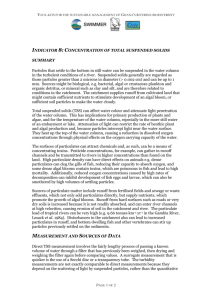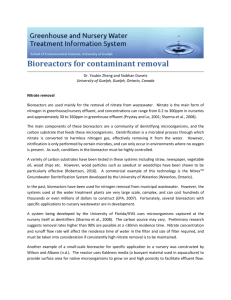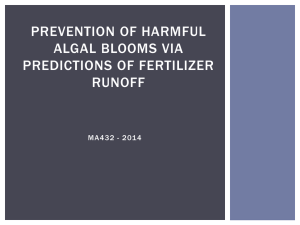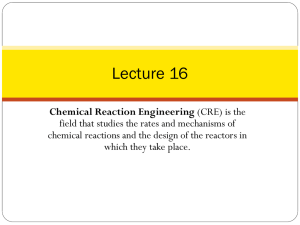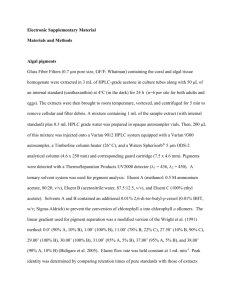Main Proposal - Minnesota Senate
advertisement
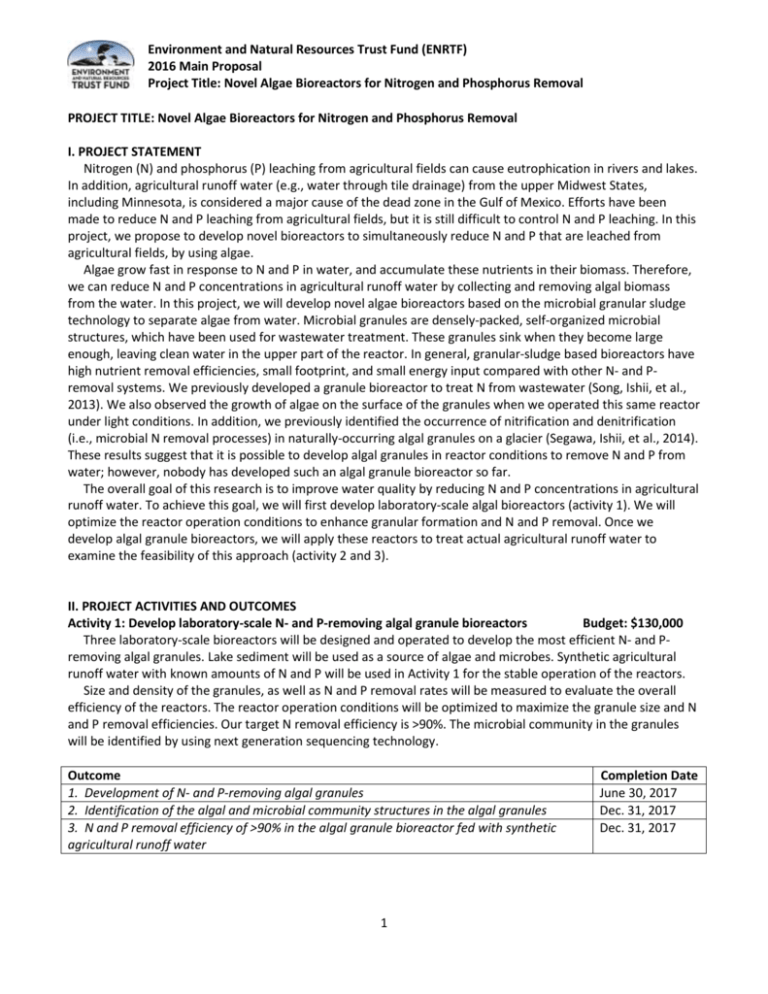
Environment and Natural Resources Trust Fund (ENRTF) 2016 Main Proposal Project Title: Novel Algae Bioreactors for Nitrogen and Phosphorus Removal PROJECT TITLE: Novel Algae Bioreactors for Nitrogen and Phosphorus Removal I. PROJECT STATEMENT Nitrogen (N) and phosphorus (P) leaching from agricultural fields can cause eutrophication in rivers and lakes. In addition, agricultural runoff water (e.g., water through tile drainage) from the upper Midwest States, including Minnesota, is considered a major cause of the dead zone in the Gulf of Mexico. Efforts have been made to reduce N and P leaching from agricultural fields, but it is still difficult to control N and P leaching. In this project, we propose to develop novel bioreactors to simultaneously reduce N and P that are leached from agricultural fields, by using algae. Algae grow fast in response to N and P in water, and accumulate these nutrients in their biomass. Therefore, we can reduce N and P concentrations in agricultural runoff water by collecting and removing algal biomass from the water. In this project, we will develop novel algae bioreactors based on the microbial granular sludge technology to separate algae from water. Microbial granules are densely-packed, self-organized microbial structures, which have been used for wastewater treatment. These granules sink when they become large enough, leaving clean water in the upper part of the reactor. In general, granular-sludge based bioreactors have high nutrient removal efficiencies, small footprint, and small energy input compared with other N- and Premoval systems. We previously developed a granule bioreactor to treat N from wastewater (Song, Ishii, et al., 2013). We also observed the growth of algae on the surface of the granules when we operated this same reactor under light conditions. In addition, we previously identified the occurrence of nitrification and denitrification (i.e., microbial N removal processes) in naturally-occurring algal granules on a glacier (Segawa, Ishii, et al., 2014). These results suggest that it is possible to develop algal granules in reactor conditions to remove N and P from water; however, nobody has developed such an algal granule bioreactor so far. The overall goal of this research is to improve water quality by reducing N and P concentrations in agricultural runoff water. To achieve this goal, we will first develop laboratory-scale algal bioreactors (activity 1). We will optimize the reactor operation conditions to enhance granular formation and N and P removal. Once we develop algal granule bioreactors, we will apply these reactors to treat actual agricultural runoff water to examine the feasibility of this approach (activity 2 and 3). II. PROJECT ACTIVITIES AND OUTCOMES Activity 1: Develop laboratory-scale N- and P-removing algal granule bioreactors Budget: $130,000 Three laboratory-scale bioreactors will be designed and operated to develop the most efficient N- and Premoving algal granules. Lake sediment will be used as a source of algae and microbes. Synthetic agricultural runoff water with known amounts of N and P will be used in Activity 1 for the stable operation of the reactors. Size and density of the granules, as well as N and P removal rates will be measured to evaluate the overall efficiency of the reactors. The reactor operation conditions will be optimized to maximize the granule size and N and P removal efficiencies. Our target N removal efficiency is >90%. The microbial community in the granules will be identified by using next generation sequencing technology. Outcome 1. Development of N- and P-removing algal granules 2. Identification of the algal and microbial community structures in the algal granules 3. N and P removal efficiency of >90% in the algal granule bioreactor fed with synthetic agricultural runoff water 1 Completion Date June 30, 2017 Dec. 31, 2017 Dec. 31, 2017 Environment and Natural Resources Trust Fund (ENRTF) 2016 Main Proposal Project Title: Novel Algae Bioreactors for Nitrogen and Phosphorus Removal Activity 2: Apply algal granule bioreactors to clean agricultural runoff water Budget: $110,000 Once we develop algal granule bioreactors for N and P removal, we will feed actual agricultural runoff water to the reactors. We will collect several agricultural runoff water samples with various N and P concentrations from different locations across the state. Stable operation of the reactors will be evaluated by the granule size and the N and P removal efficiency. If necessary, reactor operation conditions will be optimized. Outcome 1. Stable operation of algal granule bioreactors with agricultural runoff water 2. N and P removal efficiency of >90% in the algal granule bioreactors fed with actual agricultural runoff water Completion Date June 30, 2018 Dec. 31, 2018 Activity 3: Install and operate algal granule bioreactors in the field Budget: $110,000 We will select a field site where high N and P leaching is observed, and install and operate algal granule bioreactors in the field. Stable operation of the reactors will be evaluated by the granule size and the N and P removal efficiencies. We will optimize reactor operation conditions based on the climate and hydrological conditions in the fields. Outcome 1. Installation and operation of algal granule bioreactors in the field 2. N and P removal efficiency of >90% in the algal granule bioreactors in the field conditions Completion Date June 30, 2019 June 30, 2019 III. PROJECT STRATEGY A. Project Team/Partners Dr. Satoshi Ishii (Assistant Professor, BioTechnology Institute and Department of Soil, Water, and Climate, the University of Minnesota) will lead and manage the project. One post doctoral research associate and one graduate student will design and operate the reactors, measure N and P removal efficiencies, and perform microbiological analysis. Dr. Gary Feyereisen (Research Agricultural Engineer, USDA Agricultural Research Service, Soil & Water Management Research Unit) will assist with the field deployment, without funding support from ENRTF. Dr. Ishii will be responsible for the financial and all other aspects of this project. B. Project Impact and Long-Term Strategy The long-term goal of this research is to improve water quality by reducing N and P concentrations in agricultural runoff water in upper Midwest states. The proposed project is the initial step (phase 1) of a threephase project to achieve this goal. In the phase 2 project, multiple algal granule bioreactors will be installed and operated in the fields in the upper Midwest states, and their N and P removal efficiencies will be evaluated. Ecological and economic impacts of the installation of algal granule bioreactors on the water quality and sustainable agriculture will be calculated and evaluated. In this phase, we expect to have more people (soil scientists, climatologists, agricultural engineers, farmers, ecologists, economists, etc.) in the project and the support from federal agencies such as the US Department of Agriculture and the National Science Foundation (NSF). In the third phase, we will develop low-cost bioreactors (<$1,000) to promote the installation of the algae bioreactors in the fields. C. Timeline Requirements We expect to complete the proposed project in 36 months. In the first year, we will develop algal granules with synthetic agricultural runoff water, and evaluate the reactor performance (Activity 1). In the second year, we will start collecting agricultural runoff water to feed to the bioreactors (Activity 2). In the third year, we will install and operate reactors in the field (Activity 3). 2


